#language interpreters
Explore tagged Tumblr posts
Text
In what ways can simultaneous interpretation elevate the quality of your conferences?
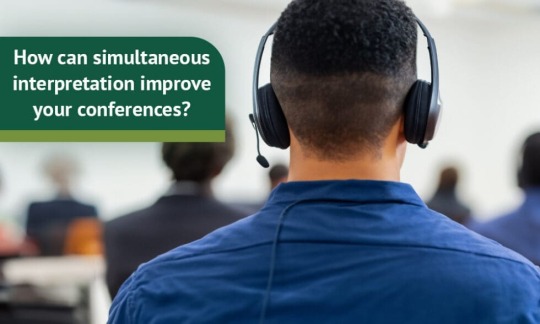
In our increasingly global world, language should never be a barrier at events, conferences, or business meetings. Conference interpreting is the key to breaking those barriers, ensuring smooth communication across different languages. At All Languages, we’re experts in helping businesses and organizations host successful multilingual events with high-quality conference interpreting services.
In this guide, we’ll cover the basics of conference interpreting, its different types, how to choose the right interpreters, and how modern technology is transforming this field.
Why Conference Interpreting is Crucial for Event Success
Effective communication is the backbone of every successful event, especially when participants speak multiple languages. Conference interpreting ensures that language differences don’t stand in the way of learning, collaboration, and meaningful engagement. Interpreters act as the bridge, helping ideas flow and ensuring everyone is included in the conversation.
At All Languages, we understand the importance of clarity and connection. Our expert interpreters make sure your event runs smoothly, fostering an environment where everyone can participate fully.
What is Conference Interpreting, and How Does It Work?
Conference interpreting is the process of translating spoken language in real time during live events. It involves listening to one language and instantly converting it into another so that participants can understand the conversation as it happens.
There are two main forms of conference interpreting:
Simultaneous Interpreting: The interpreter translates the message in real time as the speaker continues to talk. This type of interpreting is used for large-scale events, and it’s the most demanding because of the high cognitive load.
Consecutive Interpreting: The interpreter listens to the speaker for a few minutes, takes notes, and then delivers the translation after the speaker pauses. This method is common in smaller settings or formal discussions.
At All Languages, our interpreters excel at both methods, ensuring that communication flows smoothly, regardless of the event’s size or complexity.
The Three Main Types of Conference Interpreting
Here are the three most commonly used types of interpreting in conferences:
Simultaneous Interpreting: Real-time interpretation where the interpreter speaks while the speaker is talking. It’s used at large events, requiring interpreters with high skill levels. All Languages provides top-tier simultaneous interpreting services, ensuring clarity and flow during your event.
Whispered Interpreting (Chuchotage): This type of simultaneous interpreting is done on a smaller scale, where the interpreter whispers the translation to one or two participants. It’s ideal for small groups or individuals who need real-time interpretation without disrupting the event.
Consecutive Interpreting: The interpreter waits for the speaker to finish a segment of their speech before delivering the translation. This method allows for more detailed and accurate interpretation, often used in formal settings or press conferences.
How Are Conference Interpreters Selected?
Choosing the right interpreter for your event is crucial. At All Languages, we work with highly qualified interpreters who are native speakers of the target language and possess specific credentials. Our interpreters typically hold:
A Master of Conference Interpreting (MCI)
Certification from professional organizations like AIIC (International Association of Conference Interpreters)
Provincial certifications (ATIO, OTTIAQ, etc.)
These credentials ensure that our interpreters not only have linguistic expertise but also a deep understanding of cultural nuances and specialized knowledge in various industries.
Preparing Your Conference Interpreters for Success
Proper preparation is key to effective interpreting. Before your event, it’s essential to provide interpreters with reference materials like agendas, presentations, and glossaries. This helps interpreters familiarize themselves with the subject matter and ensures smooth, accurate communication.
At All Languages, we encourage our clients to share these materials in advance so that our interpreters can be fully prepared to meet your specific needs.
Determining the Right Number of Interpreters
The number of interpreters needed depends on the size and duration of your event. Interpreters typically work in pairs, rotating every 20-30 minutes to maintain accuracy and focus. For single sessions lasting up to four hours, two interpreters are sufficient for each language pair. However, for longer events or multiple concurrent sessions, additional interpreters will be necessary.
At All Languages, we assess your event’s requirements and ensure you have the right number of interpreters to guarantee flawless communication.
The Importance of Sound Quality in Conference Interpreting
Clear audio is crucial for successful conference interpreting. Poor sound quality can lead to miscommunication or errors in interpretation. Whether your event is in person or virtual, ensuring good audio quality allows interpreters to hear the speaker clearly and deliver accurate translations.
At All Languages, we collaborate with top AV professionals to guarantee crystal-clear sound, providing interpreters with the tools they need to perform at their best.
Enhancing Your Conference with AV Support
AV support plays a significant role in the success of conference interpreting. From providing interpreter booths and participant headsets to managing video remote platforms, AV professionals help ensure that your event’s technical needs are met.
At All Languages, we work hand-in-hand with AV teams to make sure every aspect of your event’s technical setup runs smoothly, allowing you to focus on the content and engagement of your audience.
How Technology is Changing Conference Interpreting
Advancements in technology have revolutionized conference interpreting, making it more efficient and cost-effective. Remote interpreting platforms now allow interpreters to work from anywhere, reducing travel costs and expanding access to skilled interpreters.
At All Languages, we utilize cutting-edge remote interpreting systems, providing flexibility for both in-person and virtual events. These technologies enable seamless interpretation across locations, making your event accessible to a global audience.
The Role of AI in the Future of Conference Interpreting
Artificial intelligence (AI) is starting to have an impact on conference interpreting. While AI tools can offer real-time translations and subtitles, they are not a replacement for human interpreters. Nuanced communication, cultural context, and tone require the expertise that only humans can provide.
At All Languages, we embrace AI as a complementary tool that enhances our services, but we believe human interpreters remain essential for delivering the highest quality communication.
Common Challenges in Conference Interpreting and How to Overcome Them
Conference interpreters face several challenges, such as fast-paced speech, technical jargon, and cultural differences. At All Languages, our interpreters are trained to navigate these challenges with precision and expertise. We provide them with the support and preparation they need to ensure that communication flows smoothly, even in the most complex situations.
How to Book Conference Interpreting Services with All Languages
Booking conference interpreting services with All Languages is simple. Contact us for a free quote, and we’ll provide you with a detailed breakdown of interpreter fees, equipment rental, and any additional services you might need.
We offer flexible solutions, including in-person interpreting with booths and headsets or remote interpreting through platforms like Zoom or MS Teams. Let us handle the logistics so that you can focus on hosting a successful event.
Conference interpreting is essential for ensuring that multilingual events run smoothly and that everyone is heard and understood. At All Languages, we combine human expertise, advanced technology, and cultural knowledge to provide top-tier interpreting services that make your event a success. Contact us today to learn more about how we can help you facilitate meaningful communication at your next conference.
0 notes
Text
Introduction
In today’s increasingly digital world, the demand for remote services has surged, impacting a variety of fields—including sign language interpreting. With advancements in technology and the need for accessible communication, remote interpreting has become a vital service, offering flexibility and broader reach for both interpreters and clients. This guide delves into the essentials of remote interpreting for sign language interpreters, exploring the nuances, challenges, and best practices associated with this crucial service.
Understanding Remote Interpreting
Remote interpreting involves delivering interpretation services via digital platforms rather than in person. This method is particularly beneficial in scenarios where in-person interpreting isn’t feasible due to distance, time constraints, or other barriers. For sign language interpreters, remote interpreting typically manifests in two forms: Video Remote Interpreting (VRI) and Video Relay Service (VRS).
Video Remote Interpreting (VRI): This service connects deaf or hard-of-hearing individuals with interpreters through a video link, often used in situations where an interpreter is not physically present.
Video Relay Service (VRS): Similar to VRI, but VRS is used primarily for telephone communication, allowing deaf individuals to converse with hearing people through an interpreter.
Differences between On-Site and Remote Interpreting
While the core skills remain the same, remote interpreting differs from on-site interpreting in several key ways. Remote interpreters must navigate the challenges of technology, manage visual and auditory clarity, and ensure a smooth flow of communication despite physical distance. Unlike in-person interpreting, remote work can sometimes lead to a disconnect in non-verbal communication cues, which are crucial in sign language.
The Role of Sign Language Interpreters in Remote Settings
Sign language interpreters play a pivotal role in bridging communication gaps for the deaf and hard-of-hearing community, especially in remote settings. The unique challenges faced by interpreters in this context include maintaining engagement through a screen, managing potential technical difficulties, and ensuring that the interpretation remains accurate and effective despite the lack of physical presence.
Read More:- https://metaphrasislcs.com/a-guide-to-remote-interpreting-for-sign-language-interpreters/
#Interpretation#Interpretation Services#language interpreters#Metaphrasis Blog#Remote Interpreting#remote services#sign language#Sign Language in Remote Communication#sign language interpreters#Video Relay Service#video remote interpreting#VRI
0 notes
Text

Since Trump took office all videos with American Sign Language interpreters have been removed from the White House website and YouTube channels. What could be the point of this beyond pure cruelty?
3K notes
·
View notes
Note
Screamer didn’t say anything about Bees raunchy wing flutters because he was too busy staring stupidly at them like a slackjawed idiot to process that other people existed around them (you know he throws a possessive hissy fit if he sees any other wingmech looking at Bees wings. Fluffs himself up and postures about so that everyone knows those wings are property of Starscream, Lord Of The Skies. And also bee I guess. By association lol. )


exactly yes he is so so petty such a child about this he LOVES it
first prev next
#thundercracker just had to go ahead and ruin everything for him#i dont think of it as 'wingspeak' persay not like any actual language exactly#more like just body language that can either be really obvious or really subtle#same as any other body language#its just that if you dont HAVE wings it doesnt come naturally to you to interpret it#starbee#starscream#bumblebee#transformers#oh uh#suggestive#i guess lol#my art
2K notes
·
View notes
Text
I'm absolutely losing my mind seeing "We need to not treat men and masculinity as inherently evil and worthy of hatred, and not fall back into biological and gender essentialism because that hurts everyone, including trans women" being misinterpreted as "Women need to stop oppressing men", "I think trans women are actually men" or "You specifically who have trauma around men need to get over it because men are the real victims". It's so willfully disingenuous. It makes me sick how willing people are to read in bad faith, especially how willing other trans women are to suddenly start harassing and dogpiling another trans woman.
I am a trans woman too, I understand what it's like to feel unsafe, but it helps no one this cynical attitude that crops up every time someone suggests being kind to men in our lives. "You could save a man you know from falling down the alt-right pipeline" is not the same as "It's your fault that men murder you". "There are people who could be on our side if we don't meet them with immediate hostility" is not the same as "You need to shut up and stop criticizing power structures for the sake of your oppressors' feelings" (I promise there are a lot of people who can be taught about their complicity in oppression without immediately shutting down but you need to work with them). This kind of attitude isn't somehow more informed or correct. It's just lashing out to avoid considering one's own agency.
Making a better, safer world for ourselves requires all kinds of work, but it's always work. It's hard to try to reach out to people who could very realistically harm us, it's work that not all of us can afford to or are able to do and that's fine because we're all just trying to survive. But some of you would rather condescend, tear each other down, and make more enemies before even considering it a possibility.
#Don't expect anymore discourse posts from me I left that life behind long time ago#I don't like to engage in discourse and I do apologize but man#“biological essentialism is bad” is not a new take#Fuck off with calling it “vibes-based” politics#absolutely rotten#If I have to see “haha nooo your so sexy don't reblog the x post” one more time I'm gonna vomit because it's always the most rancid people#whose politics revolve around being as bitter as possible and refusing to do anything#couching a refusal to do anything in leftist language and ideology#More to the point I feel like too many people interpret “you can do something to make things better” as “it's your fault things are so shit#shark rambles
2K notes
·
View notes
Text
Something that peeves me whenever I see another post going around with some variation on "autistic people take things literally which means we are the only people who communicate Clearly and Directly" is that - for any given statement, there is not one singular, agreed on, universal Literal Interpretation. If there was, none of this would be a problem!
The nature of language is that there's always some degree of interpretability. Words have several different meanings, often overlapping, and there's nuance of context, cultural references, and so on.
Faced with a statement, most people will quickly come up with an interpretation that to them makes the most sense. But if you asked a roomful of people to explain in detail their interpretations, everyone's would probably be a little different, even for a pretty simple statement. Regardless of whether those people are autistic! Everyone conceptualizes the world a little differently, and everyone has a unique personal history of all the language they've encountered, and these things effect our interpretations.
In order for communication to be workable, given this slosh in interpretability, there's another couple of processes that go on. As conversation goes on, people reassess if their initial interpretation matches up with additional context. If it doesn't, they revise it, or ask clarifying questions. And on the flipside of this process, the other person in conversation is tracking if your reactions make sense with *their* understanding of what they're trying to convey to you, and offering context or rephrasing things if it seems you're out of alignment.
These processes are social skillsets that are, like most social skillsets, not ever directly articulated or explained. Many people are bad at one or both. Sometimes you encounter someone who is really, notably good at it - the vaunted "good listener", who puts in the effort to really understand what you're trying to say, or that really excellent teacher who engages with you back and forth until you really get it. But a lot of the time, it's a sort of passive social friction - people just not getting each other.
Sometimes, you encounter someone whose brain works so much like yours that talking to them feels almost effortless - you just get each other. But that's a pretty rare occurrence for anyone. More often, as you get to know someone, you start to understand the shape of the way they interpret things and learn to account for it, so over time it's easier to make sense to each other.
It's honestly not uncommon in society for people to aggregate in groups of people who interpret things similarly, and who are thus easier to talk to, rather than actually building the skills of communicating across interpretation gaps. Particularly egregious are those groups of men who talk about Women as an incomprehensible monolith, but it turns up to a greater or lesser degree on a lot of levels.
I suspect this is the root of a lot of parenting problems - people who have never built this communication skillset, and relied on choosing friends who make sense to them without a lot of effort, and who are then totally unprepared to interact with a child who interprets things in ways they don't expect.
Obviously I can't speak to The Universal Typical Experience, not least because it doesn't exist. But in general I would posit that:
Most people, give or take a few assholes, are not trying to say things that are confusing. Most people think they are communicating clearly, because the first interpretation *they* would come up with on hearing one of their own sentences is the correct interpretation.
Many people are not very good at accounting for different ways people could interpret things they're saying. However, it is normal and polite social behavior to be somewhat flexible about this and forgiving of misunderstandings. If people are being shitty to you about not understanding them, they are assholes. And I wouldn't assume that the rest of the communication they have with everyone else they know goes totally smoothly for them.
I suspect there is a bit of an unfortunate feedback loop, where people have bad experiences when someone gets mad at them for not getting something, and learn to hide when they're confused. Which then leads to larger, more complicated misunderstandings, which other different people get upset at them about, because those people think they should have asked for clarification in the first place.
Truly you can't win with everyone. No one can win with everyone. There is no monolith of "neurotypical communication" which resolves all these contradictions - all those people you're lumping in together under "neurotypical" have just as much trouble with each other.
#this post brought to you by: the irony of people in the notes of a post about Literal Direct Communication arguing about#what would be a clearer and more unambiguous way to express the sentiment meant by 'autistic people take things literally'#'no *your* phrasing is even *more* confusing it should be -' do you see the problem yet perhaps#Look. If someone says 'I'm the only person who communicates Clearly and everyone else is the problem'#what I hear is 'I have no ability whatsoever to account for other ways people might be interpreting things differently from me'#This is all pretty longwinded. I might try to revise down a more concise version.#Concise is hard for me; that's something I'm working on#I just took out a paragraph about literal vs figurative language because it was clunking things up#But the long and short of it is that those aren't as clearly seperable as people sometimes claim#For one thing I often see 'literal speech' used to mean 'i think the interpretation is obvious' which is sure. A tautology.#anyway sorry for my rambling slash thank you for reading it#long post
2K notes
·
View notes
Text
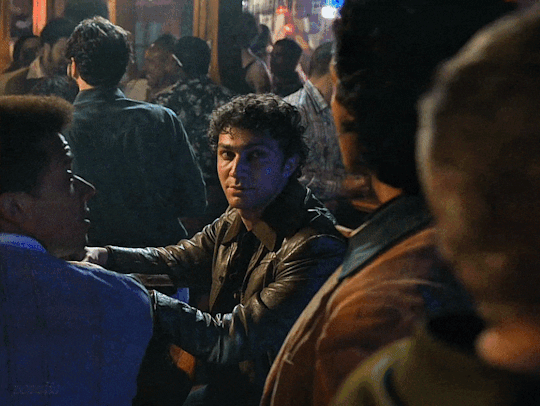


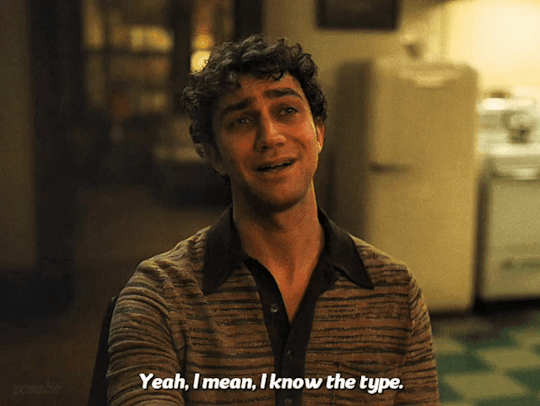
"He loved it not because it looked like a gentle, thoughtful young man, but because it was ghastly and awful and loathsome, and beautiful all at the same time. He loved it the way people love evil, because it thrills them to the core of their souls." — The Queen of the Damned, Anne Rice.
#interview with the vampire#iwtv#devil's minion#armandaniel#armaniel#armand#daniel molloy#louis de pointe du lac#ldpdl#checking each other out like that in front of louis and then daniel saying that lmao woah ok#my edits#posalisedit#gifs#gifset#s3 is too soon for anything romantic to happen between dm but just... something pls like a bit of stalking or yearning idk something pls 😣#s1e6#s2e5#also lbf was insane during the whole episode 5 but even their first meeting was so good#he did it so perfectly without a word! the body language was enough to represent louis words or even the qotd quote#i need to thank him in person for his interpretation of gayboy molloy omg
894 notes
·
View notes
Text
Amúgy ha bárki szeretne panaszt tenni az Európai Bizottságnál erről az egész borzalomról ami épp folyik, gondoltam leírom, ezeknek mond ellent az új törvény:
Megkülönböztetés tilalma: az Európai Unió működéséről szóló szerződés 2. részének 19. cikke (article 19 of part 2 of the Treaty on the Functioning of the European Union)
Gyülekezési jog: az Európai Unióról szóló szerződés 2. cikke (2nd article of The Treaty on European Union), az Európai Unió Alapjogi Charta 2. fejezetének 12. cikke (article 12 of chapter II of the Charter of Fundamental Rights of the European Union), Az emberi jogok európai egyezményének 11. cikkelye (11th article of The European Convention on Human Rights)
Adatok védelméhez való jog: az Európai Unió működéséről szóló szerződés 16. cikke (article 16 of the Treaty on the Functioning of the European Union), az Európai Unió Alapjogi Chartájának 7. és 8. cikke (articles 7 and 8 of the EU Charter of Fundamental Rights)
A szövegnek nem kell hosszúnak lennie, akár csak leírhatjátok, hogy milyen törvény ellen tesztek panaszt, utána meg bemásolhatjátok a fenti listát <3
#hungarian politics#én angolul írtam meg hogy biztos jó legyen#if anyone needs help you can text me!!#if there's any personal good in my interpreting studies it's that now I can list in ridiculous detail#all the ways in which what they're doing is fucked up dgksgdkhsjdhd#magyar#I know they know about it at the EU but the more of us send a complaint the harder it's gonna be to ignore#legally you can write it in any official EU language I just thought English is easier bc that's what most countries do speak
354 notes
·
View notes
Note
Is the gene that makes housecats black/solid the same gene that makes panthers black?
Depends on the species! Leopards have a recessive ASIP mutation just like housecats, but jaguars have a dominant MC1R mutation, the same gene that makes yellow/red variants in a lot of animals. Gain of function MC1R mutations are (co)dominant and make the animal produce more eumelanin, loss of function mutations are recessive and result in more phaeomelanin. (For ASIP, it's the opposite.)
Both genes are responsible for melanism in several felids:
ASIP: domestic cat, leopard, asian golden cat, pampas cat, kodkod
MC1R: jaguar, jaguarundi*, geoffroy's cat

*This one is interesting, because the reddish variant seems to be the original and the more common dark is the later mutation.
And the species with still unknown genetics: serval, oncilla, marbled cat, bobcat, southern tigrina, margay, jungle cat, african golden cat, african wild cat**

**Technically i think it's possible that the melanism of domestic cats is a direct heritage of the african wildcats from before domestication OR that the melanism of african wildcats is an evidence of crossbreeding with domestic cats; either way they would have the same ASIP mutation.
#i always instinctively interpret 'panther' as 'leopard' first because in my language the similar 'párduc' refers exclusively to leopards#and i have to manually initiate that No This is A Different Language; panther=jaguar or even =puma is Correct Here#ask and answer#cat genetics#other animals#agouti#extension#i'm an influencer now
1K notes
·
View notes
Text
taiwan travelogue by yang shuangzi tr. lin king is indeed an award-winning banger and perhaps the first time in my life i've ever felt vindicated for dual-wielding a novel with its english translation because the act of translation itself is such a big theme in the novel. big win for metafiction-obsessed himejin everywhere!!

#i genuinely burst into tears twice just thinking about the ending of this book#read if you enjoy: narratives about colonialism. barriers to understanding formed by language and power dynamics. FOOD AS LOVE#i also just bought the authors most recent book and its also very fun and maybe what id recommend as a lighter entry point into her work#as a yuri thats also very slice-of-life with food-as-love themes but requires less historical/cultural background to access#alas no. 1 siwei st doesnt have a translation. yet... unless.......#txt#spoilers further in tags#i think part of what makes chizuru/chien-ho such an intriguing character is carried by the conceit of translation as interpretation#her role as someone who dreams of translating novels but not one who writes them... delivering others stories to a broader audience#shes very much a character who we only get to see from the outside; most notably from the perspective of the novel's unreliable narrator#which we read as a 2nd ed translation of the original japanese text by an uninvolved third party looking back years after the authors death#but it turns out [spoilers] chizuru herself wrote the 1st ed translation and the first time we hear *her* voice is in her translators note#and her perspective and the negative space between her words are both *infinitely* fascinating#even the concept! of translating a novel where youre a main character who the narrator loves and desperately wants to understand! wtf!!!!!!#rotating her in my mind. 小千妳到底是何方聖神啊...
179 notes
·
View notes
Text
Ok but guys isn't it actually crazy how Eugene Roe's presence is literally defined by the ineffable silence of God....ep 6 has no narrative voice beyond the languageless vision of Roe's literal perspective....he brings with him silence in every episode he's in like the chaos after Jackson blows himself up stills completely when Doc runs in - they all go silent & frozen & breathless - when any man is wounded the very concept of words beyond orders fail...he talks about how Renee is blessed to calm the wounded she treats but it's evident that he brings with him something even graver than calm; it's unutterable, literally, it's a prayer, it's a response to the silence we meet (Roe meets) in his prayers (it's a reflection on the insane power we - they - have over our own - and their own - mortality - that silent and sometimes apparently godlike capacity to return (to the front lines) from the dead (that hell of lost brotherhood in the hospitals)?)
#and that's why I haven't found it in myself to write roe#because after all what is there to write#empty pages. logs of the dead. remembered prayers#its so sensory and so antithetical to the practical requirements of language#he doesn't describe - he doesn't interpret - he doesn't reflect - he experiences in the immediate#crazyyyyyyy#band of brothers#eugene roe#doc roe#hbo war#ww2#personal#bastogne#episode 6
415 notes
·
View notes
Text
In what ways does simultaneous conference interpreting benefit multilingual events?
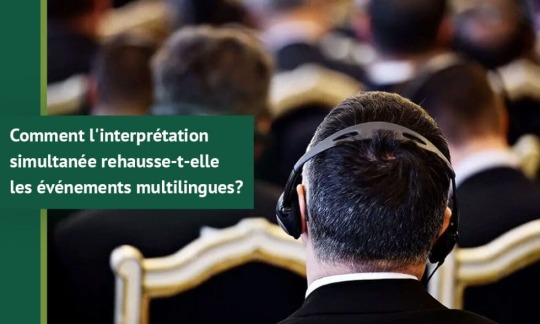
Welcome to our comprehensive guide on simultaneous conference interpreting, a transformative force in the realm of multilingual events. In today's interconnected world, effective communication knows no language barriers. Simultaneous conference interpreting stands as a beacon, illuminating the path towards seamless interaction and understanding across diverse linguistic landscapes. In this exploration, we embark on a journey to unravel the intricacies, benefits, and best practices of simultaneous interpreting. Whether you're an event organizer, participant, or language enthusiast, prepare to immerse yourself in the world of simultaneous conference interpreting like never before.
1. What exactly is simultaneous conference interpreting? Simultaneous conference interpreting is a specialized form of interpretation where skilled linguists render spoken content into the target language in real-time, synchronously with the speaker. This dynamic mode of interpretation is the cornerstone of multilingual events, ensuring fluid communication across language barriers.
2. How does simultaneous interpreting elevate multilingual events? Simultaneous interpreting serves as the catalyst for elevating multilingual events to new heights. By seamlessly translating speeches and discussions in real-time, it fosters inclusivity, engagement, and comprehension among participants from diverse linguistic backgrounds.
3. What are the primary advantages of simultaneous interpreting?
Seamless communication: Simultaneous interpreting facilitates smooth and uninterrupted communication flow, enabling participants to engage with content without delays.
Time efficiency: By eliminating pauses for interpretation, simultaneous interpreting optimizes event schedules, maximizing productivity and audience satisfaction.
Enhanced engagement: Participants can fully immerse themselves in the event's proceedings, leading to heightened interaction, collaboration, and knowledge exchange.
Accuracy and fidelity: Skilled interpreters ensure that the essence, nuances, and subtleties of the original message are faithfully conveyed, preserving the integrity of communication across languages.
4. What are the main challenges faced in simultaneous interpreting?
Cognitive demand: Simultaneous interpreters must possess exceptional cognitive abilities to process, analyze, and convey information accurately in real-time, often under high-pressure conditions.
Technical requirements: Successful simultaneous interpreting necessitates the use of specialized equipment such as soundproof booths, microphones, and headsets to facilitate clear communication, adding logistical complexity to events.
Fatigue management: The intensive nature of simultaneous interpreting can lead to mental and physical fatigue over prolonged periods, requiring interpreters to implement effective strategies for rest and rejuvenation.
5. How can event organizers ensure the effectiveness of simultaneous interpreting?
Partner with reputable language service providers: Collaborate with established language service providers to enlist qualified interpreters with expertise in simultaneous interpreting.
Provide adequate resources: Ensure that the event venue is equipped with state-of-the-art technical infrastructure, including soundproof booths, quality microphones, and headsets to optimize interpretation quality.
Plan meticulously: Communicate language requirements and event details to interpreters well in advance, allowing sufficient time for preparation and coordination to ensure a seamless interpreting experience.
Simultaneous conference interpreting stands as a cornerstone of successful multilingual events, transcending linguistic boundaries to unite global audiences in meaningful dialogue and collaboration. By embracing the principles, benefits, and challenges of simultaneous interpreting, event organizers can harness its transformative power to create immersive, inclusive, and impactful experiences for participants worldwide. We trust that this FAQ guide has provided valuable insights into the essence of simultaneous interpreting and its pivotal role in shaping the future of multilingual communication.
0 notes
Text
Reading the novelization of A New Hope already changed how I saw Luke as a character but Splinter of the Mind’s Eye is going one step further and making me question the very fundamentals thought to be obvious about Luke.
Like, Luke is, for lack of a better term, a nerd. He studied languages and cultures -
“”Yes,” Luke admitted modestly. “I used to study a lot about certain worlds, back on my uncle’s farm on Tatooine. It was my only escape, and educational as well. This,” and he indicated the creature resting a massive long arm on his head and shaking him in a friendly fashion, “is a Yuzzem.””
-he wants to study more languages and cultures-
“Empty doorways beckoned to him and he was tempted, very tempted, to enter one of the ruined structures to find out if its interior was as well preserved as the outside.
This was not, he reminded himself firmly, the time for playful exploration. Their first concern was to find a way out, not to go poking around this ancient metropolis. However wonderful it was.”
Luke wants to know about people. He wants to know about cultures and creatures and he wants to be able to communicate and…
He really just. Is a great Jedi. He jumps between Leia and danger and he befriends the Yuzzem the prison guards thought would kill him and he wants to explore the creepy abandoned ruins of a civilization long past and he uses Anakin’s lightsaber underwater to cut the stem of a lilypad they use as a boat and he comments that the rock formations are almost too beautiful to cut down and he knows how to work Imperial explosives and
He’s a Jedi, man. He’s a Jedi. He’s been a Jedi this whole time, before any of us even knew what that actually meant.
#the inane ramblings of a madman#star wars#luke skywalker#long post#splinter of the mind’s eye#sw novels#listen listen listen#i’m like ninety nine percent sure most of this book is canon to legends’#and like#later portrayals of luke have to be based on this one#he wants to learn and he wants to communicate with people#also the language of the yuzzem is mostly grunts and growls and chitters#so i have to assume luke could also speak shyriiwook if he wanted#luke in the christmas special understanding what chewie and his family’s saying#is made all the funnier with knowledge of other languages luke has learned#i’m rethinking how i’ve been writing and interpreting luke this whole time#he’s a massive nerd and i never even truly understood the extent of it#tragic
517 notes
·
View notes
Text

daisy bell gives me so many fatal error vibes that i can't describe it
swap sans by popcornpr1nce fatal_error by @xedramon
#ofc based on that headcanons post tee hee#this specific comic is a bit far from what i said about the jukebox thing#so mayyyybe i'll draw more stuff about this hc i love it so much#oh and the only explanation i'm giving is what gaster flowey is saying#“pathetic” “haha”#yup sign language#the rest are direct references to the fatal comic:3#except the last 2 panels#what is fatal making is more up to interpretation#i have a specific idea but let's just say it's probably some creepy stuff that occurred to his twisted little mind#undertale#undertale au#utmv#underswap#swap sans#blueberry sans#fatal error sans#fatalberry#fluffy art
809 notes
·
View notes
Text




The Language of Flowers: An Alphabet of Floral Emblems – published by T. Nelson and Sons (1857) // Maroon – Taylor Swift
#love that this version of the language of flowers implies that this lyric can be interpreted as:#“fascination that you had thought was love... that's us” 💔💔#carnation#carnations#rose#roses#language of flowers#the language of flowers#maroon#maroon song#maroon taylor swift#midnights#midnights album#taylor swift midnights#midnights taylor swift#taylor swift#ts edit#tsedit#tswiftedit#tswift edits#art#art history#lyrics#lyric art
371 notes
·
View notes
Text
Dean Winchester & hug dynamic analysis
I was thinking about how whenever Dean hugs someone he's almost always the one hugging the other and how this links to his psychological trauma of always being the caretaker of people, making himself bigger to protect them.
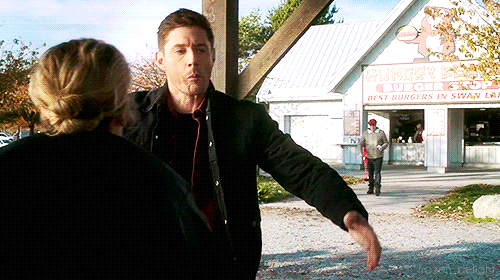

Because that's how Dean sees himself, as a shield for others, and then I thought about how Cas actually is the shield, and he's HIS SHIELD, specifically, the only one who's really there to protect HIM, which is why it hits so much when we see this:
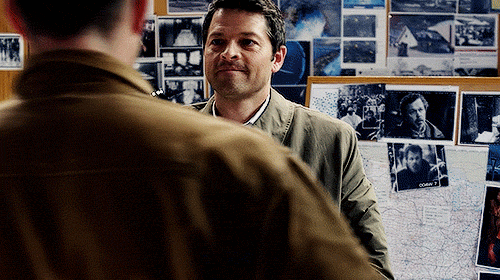

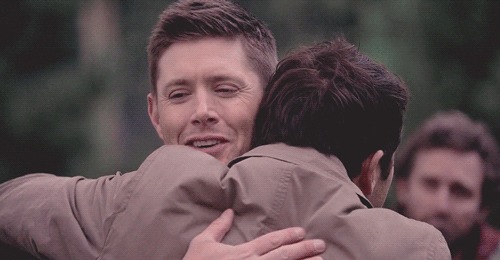
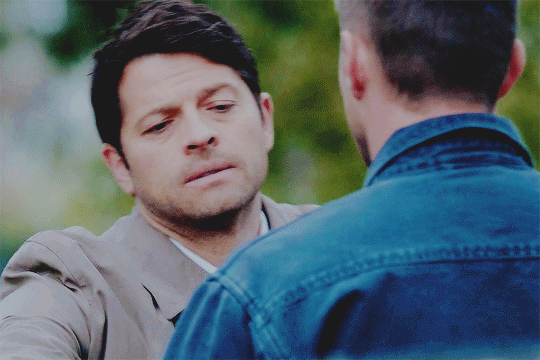
The way Cas wraps his arms around him, trying to protect him with his whole body--that he'd use as a shield and give up in a second if he could spare him from any pain and save him.
(for context: Dean was about to go use the soul bomb on Amara there, it was a suicide mission)

Bobby is another one that hits, he hugs him as the big hugger because he's his father, he loves him and he's actually here to protect him (and Dean LETS him -barely, but he lets him *and Cas* - in a way that he doesn't let Sam)
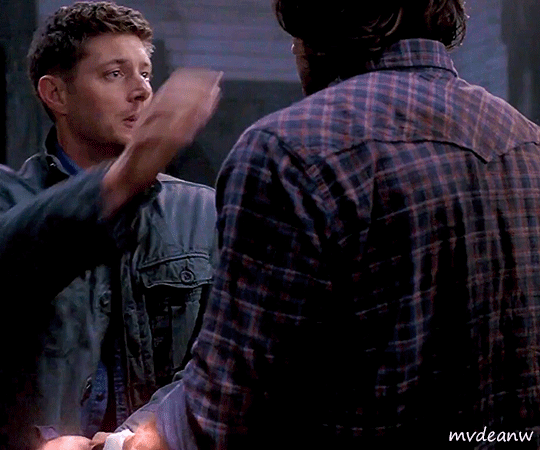
I watched a compilation of Sam & Dean hugs to check if i was right about it, but it's almost always Dean the big hugger with Sam, except when he's about to die or Sam sees him alive again after losing him.


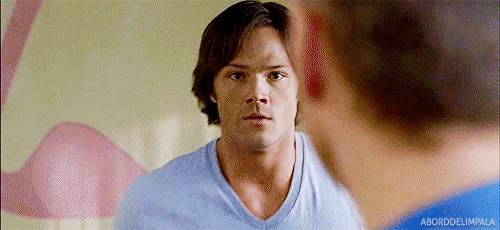
Even then, Dean mostly tries to hug Sam as the big hugger anyway, with at least one arm, like a way to comfort him, making him feel protected, like his body language is saying "I'm here, I'm okay, I'm still strong, i can still protect you" (because their real father failed and Dean thinks it's his job).

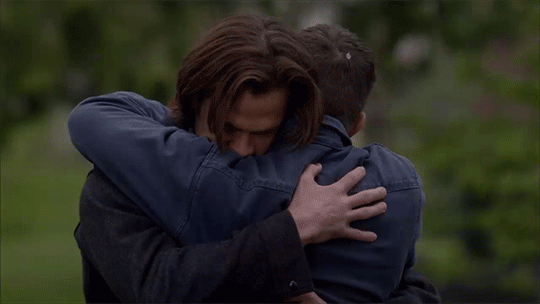
He rarely lets himself be the little one hugged with Sam, unless he's barely conscious. Which is why it kills me so much more now that in this moment (s14, when Dean was going to lock himself in the Ma'lak box cause he was possessed by Michael) and Sam has a desperate breakdown and punches him (to stop him) he forcefully hugs him as the little hugger, the way Dean always kept him, like a way of saying "I still need you to protect me, please don't do this to yourself".
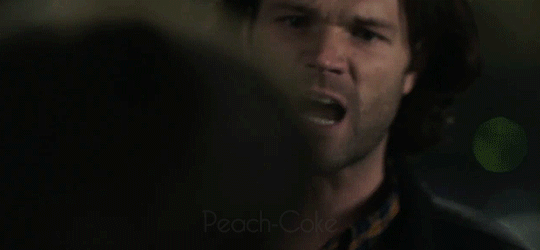
In the scene below he gives Sam his blessing to do a dangerous (possibly suicidal) mission, and one of his arms is down, but the other one tries to stay up--he's forcing himself to do it and he struggles because he still wants to protect him, but (as the seasons progress) he slowly becomes more prone to let go.

So in this view the hug dynamic becomes an indicator of how Dean sees Sam (and himself) and his protector role, how adult and self sufficient he considers Sam, and how much he lets people around him take care of him, lowering his walls and letting himself be hugged.


This is also why i think hugs from characters like Garth or Charlie are so special, because they're just like us: they see Dean and they just know that he needs to be hugged a lot, and that he's not used to it, so they just go for it-- and it's so normal and kind and spontaneous that Dean's just not used to it-- he doesn't know how to respond (especially with Garth, at the beginning, but as the seasons progress, he learns to, and he even initiates the hug eventually).
youtube
I love the hugs where they're 50/50 (one arm up, one arm down both), feels like they're equals, both taking care of each other. I feel like with Sam and Dean, this indicates a healthier dynamic, because Dean lets go a little of the role that was imposed to him and manages to see Sam as the strong individual that he is. But the same applies to 50/50 hugs with other characters, like with Cas, where I feel like it testifies how equals they feel in terms of being fighters, there's a show of respect of each other's strength that transpires by the gesture (which is even more astounding considering that Cas is literally a powerful angel).


And just to end on a destiel note, I'd like to note the possessiveness and protectiveness of Dean (rightfully so) whenever he finds Cas after he thought he had lost him, and how that translates into his body/hug language:
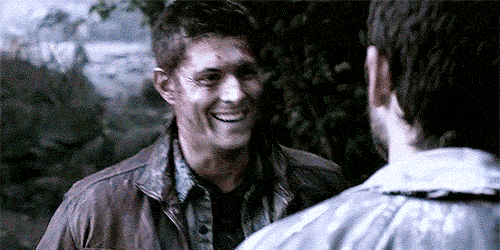


#dean winchester#spn#dean winchester character study#spn analysis#dean winchester analysis#dean winchester & hugs#dean studies#destiel#deancas#body language#hugs#dean winchester hugs#castiel#sam winchester#sam & dean#sam & dean dynamics#dean x cas#psychology#my thoughts#my interpretation#my analysis#spn gifs#dean winchester gifs#Youtube#long post#but it's mostly many gifs#no that's not true i also wrote a lot (but it's little paragraphs in between more gifs than the mobile app allows)#(I did it from the website to cheat)#(i hope it doesn't lag too much)
3K notes
·
View notes